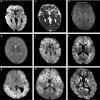Acute encephalopathy in children with tuberous sclerosis complex
- PMID: 33407677
- PMCID: PMC7789140
- DOI: 10.1186/s13023-020-01646-8
Acute encephalopathy in children with tuberous sclerosis complex
Abstract
Objective: We examined the clinical manifestations of acute encephalopathy (AE) and identify risk factors for AE in children with tuberous sclerosis complex (TSC).
Methods: The clinical data of 11 children with clinically diagnosed TSC associated with AE and 109 children with clinically diagnosed TSC alone aged 4 years or older were collected from 13 hospitals.
Results: Of the 11 children with AE, 5 had histories of febrile seizures (FS), and all had histories of febrile status epilepticus (FSE). AE developed within 24 h after fever onset in all children with seizures lasting 30 min or longer. All children developed coma after seizure cessation. Head magnetic resonance imaging (MRI) revealed widespread abnormalities in the cerebral cortex, subcortical white matter, corpus callosum, basal ganglia, and thalamus. One child died; seven had severe neurological sequelae; and the other three, mild sequelae. Logistic regression analysis revealed that a history of FSE was correlated with the development of AE.
Significance: AE in children with TSC was characterized by sudden onset after fever, followed by coma, widespread brain edema evident on MRI, and poor outcomes. A history of FSE was a risk factor for the development of AE.
Keywords: Clinical neurology history; Infantile spasms; MRI; Prognosis; Status epilepticus.
Conflict of interest statement
Anonymized data and materials can be made available upon reasonable request to the corresponding author.
Figures

References
Publication types
MeSH terms
LinkOut - more resources
Full Text Sources
Other Literature Sources
Medical

